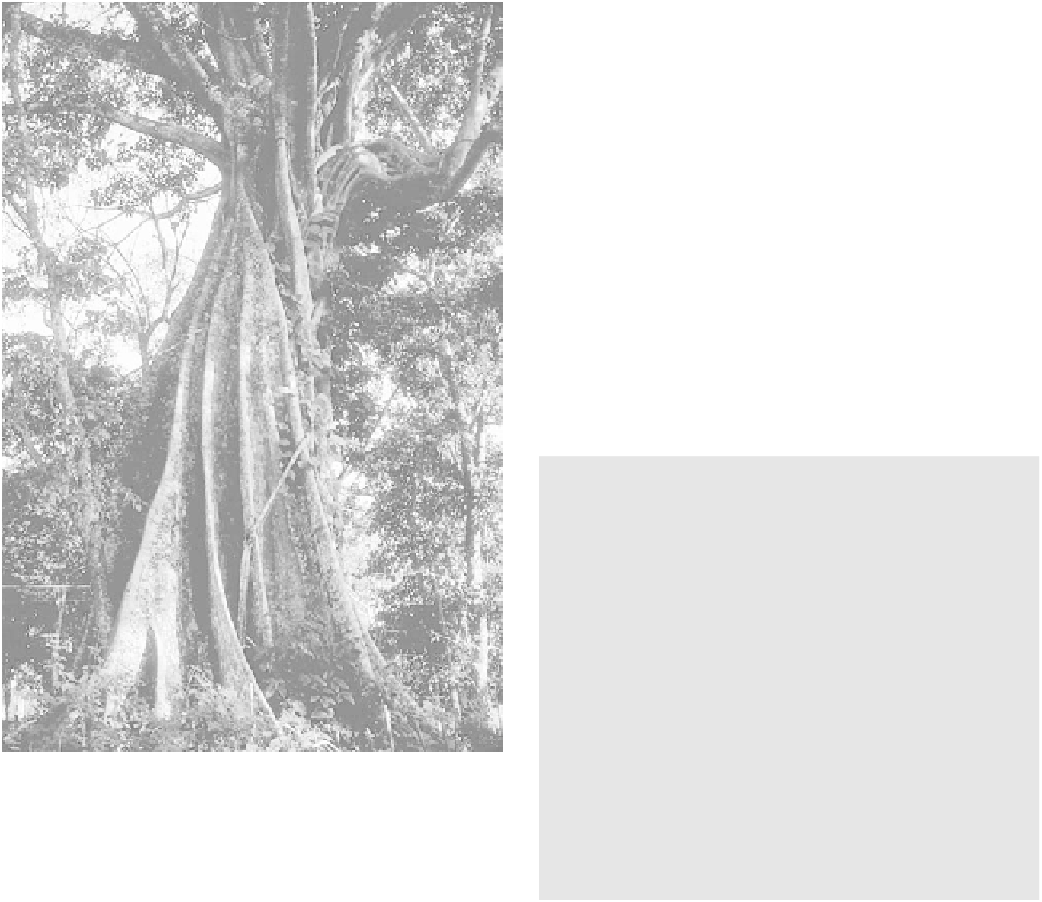Geography Reference
In-Depth Information
Beneath this exceptionally rich environment lies a
more humid, darker understory and the forest floor. Ferns,
bamboo, shrubs, and herbs shade a relatively open floor
that is strewn with decomposing plant and animal litter
and fungi. This rather thin layer provides some nutrients to
vegetation. However, most tropical soils are deceivingly in-
fertile, leached of their nutrients by copious rainfall and
high temperatures. At lower layers, aluminum and iron ox-
ides form rock-like layers called
laterite.
Since antiquity ,
laterite has been cut and used as building blocks for temples
and other structures. Even giant trees have shallow roots to
tap the litter layer for food. Some of these have supportive
bases called
buttresses
(Figure 2-12).
Where light penetrates, dense growth can be found
at floor level. Dense vegetation, or jungleexists along
rivers or in areas that have been cleared and abandoned.
These seemingly impenetrable areas belie the more open
rain forest in their vicinity .
Humans have decimated Earth' s rain forests by clear-
ing vast areas for settlement and such activities as cattle
rearing and plantation agriculture (e.g., palm oil).
Millions of acres have been removed for timber and fire-
wood. Worldwide, 65,000 square miles (169,000 km
2
) of
rain forest, an area nearly the size of Wisconsin, is lost.
Logging, plantation agriculture, and their impacts will be
discussed further in the regional chapters.
TROPICAL MONSOON FORESTS
Found primarily in mainland Southeast Asia and the
Indian subcontinent, the monsoon forest is a transitional
biome between tropical rain forests and grasslands.
Unlike tropical rain forests, monsoon forests must adapt
to distinct wet and dry seasons. Many trees are semi-
deciduousthey lose part of th eir foliage in the dry
months (Figure 2-13).
T Tropical monsoon forests lack a continuous canopy .
Their trees average only 50 feet (15 m) in height. Often
cut for firewood, they make poor lumber for construc-
tion. T Teak, a highly valued hardwood for carpentry , is an
exception. T Trees also produce waxes, gums, resins, and
lacquer. Monsoon forests possess a rich collection of
wildlife including tigers, sloth bears, and the one-horned
rhinocerous.
Do your shoes have rubber soles? Do you use a palm
oil-based soap? Have you used lacquer or latex paint?
Have you used bamboo skewers or wooden chopsticks?
Is there a coconut fiber mat at your front door? Bought
any bamboo products lately? How much of the tropical
forest are you using?
Riches of the Tropical Forests
T Tropical forests are rife with desirable products such
as fruit, tubers, plants, and other food crops; rattans
and fibers; oils and resins, in addition to wood. T Tradi-
tional ways of gathering forest products have little
impact compared to modern logging activity . Logging
is a prime reason why more than 40 percent of Asia' is
Figure 2-12
Here is a dramatic example of a buttressed tree in the tropical
rain forest. Since soil fertility is at the surface, trees develop
sprawling surface rather than tap-root systems. Some large
species of trees develop blade-like supports like these.
Photograph
courtesy of B. A. Weightman.



















Search WWH ::

Custom Search